OldMan&theWeed
Member
I want to increase trichome production on my buds. To this end I read several studies available on the internet. From a study entitled “Interactive effects of jasmonic acid, salicylic acid, and gibberellin on induction of trichomes in Arabidopsis” by Traw and Bergelson, I learned that that, “…gibberellin and jasmonic acid had a synergistic effect on the induction of trichomes, suggesting important interactions between these two compounds.”
http://www.citeulike.org/group/2438/article/853395
From this PGRs thread, I leaned that a good economical source of jasmonic acid was Jaz Rose Spray (thank you Spurr). I already had some gibberellic acid that I bought a while back. Now I had everything to start my experiment.
I already had some gibberellic acid that I bought a while back. Now I had everything to start my experiment.
The strain I used were six Bubblicious from Nirvana in their fourth week of flower, all in the same cabinet. I broke them into three groups. With two, I did nothing, Two others I removed from the cabinet and administered a spraying of Jaz Rose Spray (jasmonic acid). And the last two I removed from the cabinet and administered a dose of Jaz Rose Spray and gibberellic acid, as described by Traw and Bergelson. After the four plants had dried, I returned them to the cabinet.
Ten days later this is what I see:
The plants that received no treatment are progressing as Bubblicious always does, with light visible trichs on the buds, but very little frosting on the sugar leaves.
The plants that received jasmonic acid treatment only, show heavy visible trichs on the buds, as well as a light frosting of trichomes on the sugar leaves.
The plants that received the mix of jasmonic acid and gibberellic acid also show heavy visible trichs on the buds, a light frosting of trichomes on the sugar leaves AND a great deal of FOXTAILING. Foxtailing is considered a disagreeable trait by most gardeners.
Because of my strong attachment to my freedom, and a lack of technical prowess, I will not be posting any pics.
I hope this provides fodder for people more expert than me to examine more carefully the effect of jasmonic acid on trichome production.
http://www.citeulike.org/group/2438/article/853395
From this PGRs thread, I leaned that a good economical source of jasmonic acid was Jaz Rose Spray (thank you Spurr).
 I already had some gibberellic acid that I bought a while back. Now I had everything to start my experiment.
I already had some gibberellic acid that I bought a while back. Now I had everything to start my experiment.The strain I used were six Bubblicious from Nirvana in their fourth week of flower, all in the same cabinet. I broke them into three groups. With two, I did nothing, Two others I removed from the cabinet and administered a spraying of Jaz Rose Spray (jasmonic acid). And the last two I removed from the cabinet and administered a dose of Jaz Rose Spray and gibberellic acid, as described by Traw and Bergelson. After the four plants had dried, I returned them to the cabinet.
Ten days later this is what I see:
The plants that received no treatment are progressing as Bubblicious always does, with light visible trichs on the buds, but very little frosting on the sugar leaves.
The plants that received jasmonic acid treatment only, show heavy visible trichs on the buds, as well as a light frosting of trichomes on the sugar leaves.
The plants that received the mix of jasmonic acid and gibberellic acid also show heavy visible trichs on the buds, a light frosting of trichomes on the sugar leaves AND a great deal of FOXTAILING. Foxtailing is considered a disagreeable trait by most gardeners.
Because of my strong attachment to my freedom, and a lack of technical prowess, I will not be posting any pics.

I hope this provides fodder for people more expert than me to examine more carefully the effect of jasmonic acid on trichome production.





